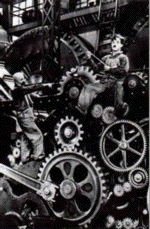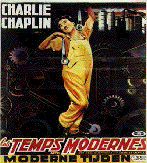Monotonous situations have become
increasingly prevalent in industrial assembly
line production systems where repetition of
simple tasks tends to result in boredom and
decrement of performance. The so-called 'gear
wheel sentiment' of assembly workers seerns to
have become stronger in recent years.
Relating the observations of workers'
behavior and workers' subjective statements to
the variability of the output, Wyatt et al.
(1929) reported that monotonous repetitive
operations greatly changed behavior
patterns resulting in workers looking around,
talking with neighbors, stretching,and
yawning. Kirihara (l 960) further showed
through introspective methods that boredom was
extensively modified by the paced or unpaced
nature of a repetitive task. Boredom is also
known to be related to changes in physiological
conditions of workers in terms of visual
functions, electroencephalographic changes, and
other indices of the level of arousal. It is
thus postulated that the incidence of boredom
varies widely in relation to the complexity of
the task, and that the brief distractive
activities intermediating the work are
significant to maintain performance).
Recently Saito et al. have conducted studies
in cooperation with a specialist committee on
monotony problems sponsored by the Ministry of
Labour. Their studies showed that the feeling of
monotony accompanied by various changes in
workers' attitude is greatly dependent upon the
time reserve of the repetitive task. The author
took part in these studies and has tried to
reveal the relationship between the boredom and
the subsidiary behaviorofworkers not directly
relevant to the work. The presentpaperattempts
to clarify the occurrence of such distractive
behavior as a function of the time reser~e
included in workin patterns.
[...]
DISCUSSION : Increases in frequency
of both chattering and other subsidiary
activities such as changing positions, looking
around, yawning, etc., were observed at all
types of the work patterns including the
severely paced conveyor work. Those behavioral
changes had large individual differences and
very high frequencies were usually found among
10-30 %. of the whole cases.
In the present study, the workshops showing
the least increase in those subsidiary
activities with the work were severely paced
conveyor lines with fixed work rates. The
workers on these paced lines had to work the
same procedure through the day's shift at a
constant and relatively fast rate. This might be
against the expectation that a paced work would
lead to more frequent compensatory movements due
to its monotonous situations. In reality,
however, these workers had less occasions to
wait for the next assembly task, and the less
chances they have to wait, the less was the
subsidiary activities except chattering, as
shown by Fig. 6 for one of these workshops. The
limitation of voluntary subsidiary actions
irrelevant to the assernbly work on these
conveyor lines may be suggested by the fact that
this kind of work produced very small variation
of work cycles during the shift period. It is
thus postulated that a strictly paced rhythm of
conveyor work restrict the free onset of
compensatory movements.
The conveyor lines with variable tasks showed
in general earlier and higher increase of both
chattering and other subsidiary actions, while
the table system workers showed their moderate
increase. Less frequent appearance of subsidiary
behaviors in the table-type assembly work may be
explained by the frequent changes of minor
processes included in each relatively long cycle
time. The marked increase of the cycle time in
the later hours of the table system work
indicates that the comparatively small frequency
of the subsidiary behaviors was not due to the
time restrictions. Frequent changes of working
positions and motions as weil as frequent shift
of attention would account for the reduction of
the need for subsidiary activities. In contrast,
the conveyor work, if moderately paced,
brings about frequent compensatory activities in
terms of chattering, changing positions, looking
around, arranging hair, closing eyes,
yawning, etc.
The incidence rate of these subsidiary
behaviors was reduced by insertion of short
pauses, lunch recess, or short gymnastics,
especially among workers of the conveyor
workshops with variable tasks such as bottling
of various kinds of enamel manicures. Such
workers also revealed a decrease of subsidiary
actions during the last half-hour period of the
working day. These facts suggest that the
increase in subsidiary activities is produced by
the monotonous working situations.
Although chattering with neighbors can be
done without influencing manual operations, it
was less frequent on conveyor lines with severe
pacing. Since no correlation was found between
waiting frequency and chattering even in a
severely paced workshop, the observed
suppression of chattering on such conveyor lines
may be due to the fast pacing situation as a
whole. On the conveyor lines with variable tasks
where the chattering was the most frequent, its
frequency was correlated with frequency of other
subsidiary activities.
Wyatt et al. (1934) and Kano (1962) pointed
out that chattering of workers increased in
accordance with the reduction in work output.
WYATT suggested that it reduced the boredom and
drowsiness. In the workshops of the present
study where the pace of work was strictly
controlled by the conveyor speed, however, not
only chattering but also other voluntary
subsidiary actions were too reduced to
compensate the boredom. These workshops had more
persons whose critical flicker frequency or
color-naming speed much declined. The workers
under such strict pacing by the conveyor belt
also had higher rates of subjective fatigue
feelings than assembly workers of other working
patterns. The fatigue feelings were dominant
especially for symptoms of the dull-drowsy
factor and for shoulder stiffness.
Saito et al. have shown that the reduction in
the detection rate of wrong boules was closely
associated with the rate of drowsiness during
boule inspection. The high rate of drowsiness
was usually observed in workshops of inspection
or assembly tasks where the strictly paced work
rate did not allow changes in the working
habits. In one of serial reports on industrial
monotonous work, Saito et al. (1969) discussed
the relationship between distractive actions
including chattering and what they called
negative work feelings. They concluded that the
increased distractive activities of monotony
workers might be dependent upon the appearance
of feelings of boredom and aversion. The author
has confirmed that the critical flicker
frequency was maintained at a high level when
chattering was vivid and frequent and hence the
negative feelings of workers were little.
Although it is clear that momentary
distractions by periodical changes of activity,
brief rest pauses, chattering, and others serve
to maintain performance, such distractive
behavior seemed to be remarkably reduced in
paced work when the workers are apt to be
drowsy, their compensatory effects being all the
more decreased. In the same manner, the work
patterns allowing less free activities of
individuals result in lower level of arousal and
in decrement of performance. It is reasonably
assumed that the boring effects of repetitive
work on strictly paced conveyor lines may be
accelerated by the restriction of subsidiary
behaviors. Thus the frequency of subsidiary
activities may be used as an indication of the
degree of freedom of paced work. Ample reserve
time for those distractive activities should be
considered important to prevent the monotony
effects of repetitive work patterns.



![]()
